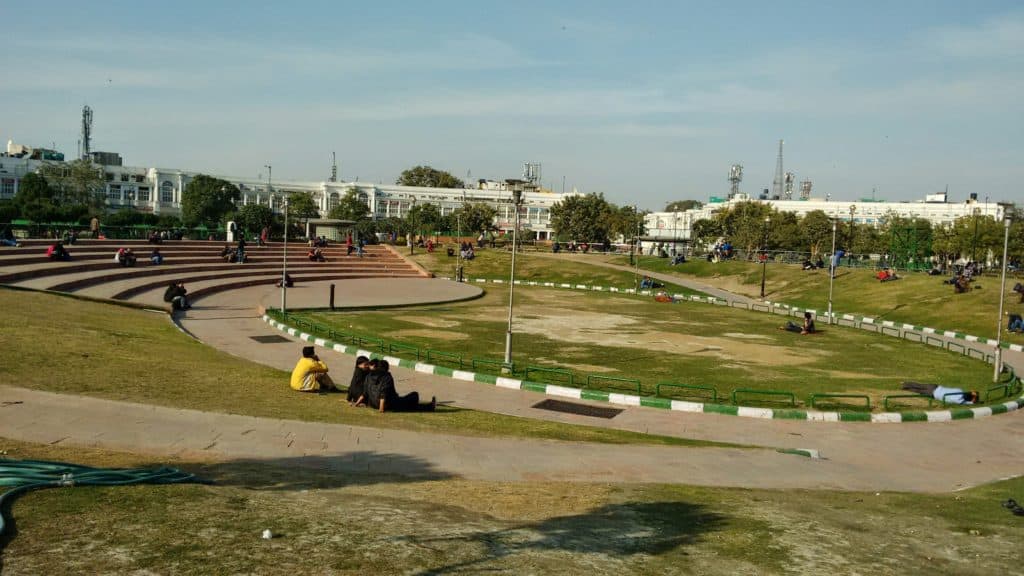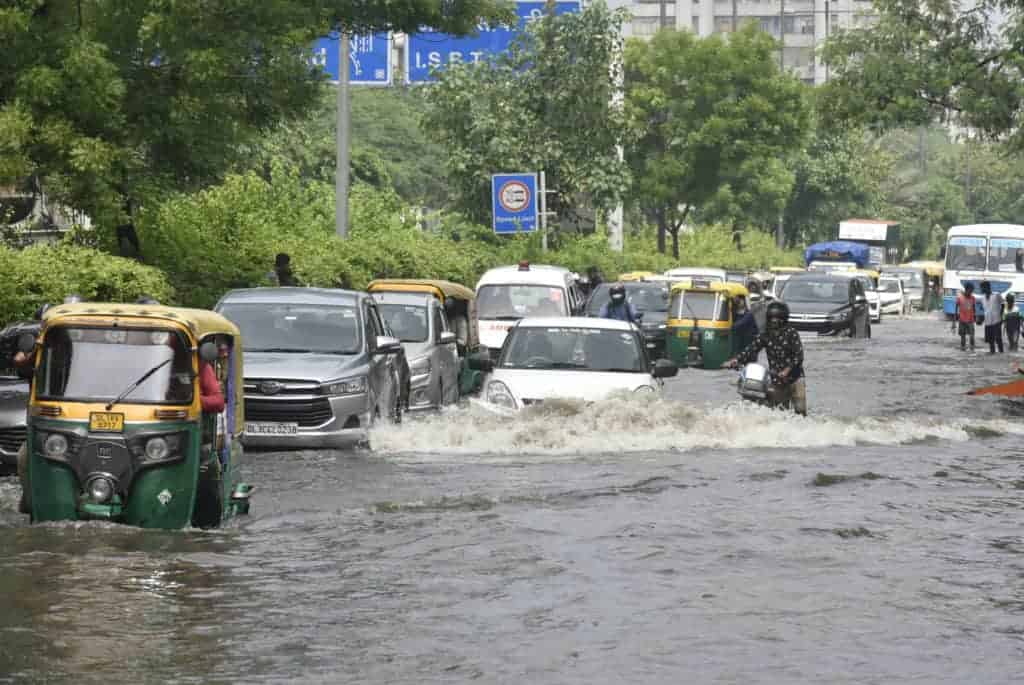“3424 million litres run-off quantity is the missed potential, which sometimes becomes a liability in the city,” says the Centre for Science and Environment (CSE), the Delhi-based pro-environmental think-tank that has long been making a case for rainwater harvesting in parks and open spaces. “If managed efficiently, the run-off can be stored, recharged and moderated during peak rainfall”.
Delhi has had a bad water year this summer. Even the “piaos” that many large hearted people set up outside their homes in different parts of the city to distribute water have gone dry this year,
The gap between demand and supply has been widening year after year — a fact well known to the Delhi Jal Board. There’s been a continuous war of words over water amongst the states around the national capital, all of which in some way supply water to Delhi. Water from Haryana is carried through two canals, and the water from Uttar Pradesh through the Upper Ganga Canal. The underground water tapped by the DJB is from its Ranney wells and tube wells.
Now, as Delhi gets its first drops of rain, there is renewed talk of implementing more rainwater harvesting (RWH) measures and that the government should step in to monitor and evaluate the implementation of the laws and guidelines around rainwater harvesting. (RWH is mandatory for constructions on plots that exceed 100 square meters).
But monitoring remains patchy. Many group housing societies and some independent homes are doing it. But many more are not, and have reasons to explain why they feel their investment in RWH systems will only get washed away with the dust that the scanty rain waters take with them.
Read more: What the Jal Jeevan Mission must focus on to fix urban water supply
Fortunately, there are diehard fans who strongly believe in RWH. Like Delhi resident Manohar Khushalani, a former director of the National Water Academy at Khadakwasala. Khusalani has installed a water harvesting structure at home, and has been harvesting every drop of rainwater that his house receives for about 20 years now.
“I built this in 2003 when my 60 feet deep tube well dried up,” says Prof Khushalani, the author of five books on water and irrigation practices and is now professor at the Indraprastha Institute of Information Technology. “I decided to divert all the rainwater that collects on my terrace into this well”.
Rainwater harvesting, he adds, is just one way of conserving water. “It is not very difficult, nor is it expensive to harvest rainwater. It can be done easily in group housing societies as well as individually. We just have to be responsible and think about the next generation that will also need water”.
One important element when people use rainwater to recharge underground aquifiers is to ensure it is filtered so that it does not contaminate the ground water. For the same reason, water on the roads during the rains should not be used to recharge ground water, he argues.
“If rainwater is allowed into a deep well of about 60 feet or more, the soil will filter it automatically,” says Khushalani. The rainwater collected on his terrace flows down a pipe connected to a bore, where after 60 feet, the soil filters the water.
Khushalani’s love affair with water conservation and rainwater harvesting has resulted in him talking on the subject from multiple platforms, for he believes Delhi’s water problem can be solved by scientific planning.
Courts intervene
Rainwater harvesting is mandatory for all new buildings where the rooftop discharge is 10,000 litres or more per day. According to the Delhi Jal Board, water connection will be granted to new houses only when a zonal engineer certifies that the building plans sanctioned by the Municipal Council or the Delhi Development Authority includes the requisite RWH systems.
At a time when independent houses are giving way to apartment complexes of varied sizes, bulk water connection is given only when the builder adduces a certificate by the executive engineer or superintending engineer of the area that the building has a functional rainwater harvesting structure installed.
Failure to install an RWH system will invite a penalty of 1.5 times the water bill for all properties on 500 square metres or more. But the capital’s affair with rainwater harvesting has been anything but steady. There is a commitment to RWH, complete with guidelines, but there are also many occasions when the courts have had to step in to seek compliance.
On June 27th, the Delhi High Court issued notices to various government departments on the basis of a news report highlighting the lack of rainwater harvesting facilities in the capital. The case was heard on July 4th, when the court granted four weeks time to the Centre, Delhi Government and other authorities for filing status reports in the case which will next be heard on July 29th.
In January 2019, the National Green Tribunal imposed a cost of Rs 5 lakh each on educational institutions in Delhi that had not installed rainwater harvesting systems in compliance with a November 2017 order directing that these be installed in two months. They even slapped a fine of Rs 5000 each on three officers of the Education Department for failing to comply with orders regarding installation of RWH system.
The NGT had also asked the Registrar of Delhi University, among others, to submit a list of educational institutions where the system was not installed or was not functional.
During the 2020 monsoon, the Delhi Jal Board incentivised people to set up RWH systems in their homes. All properties on plots over 100 square metres constructed after 2001 must have a functioning rainwater harvesting system, as per its rule.
As an incentive, the government provides a partial one time monetary subsidy for the structure and a 10% rebate on the water bill. Architects empanelled with the state government can certify that RWH systems have been installed and are functional, on behalf of builders and owners of plots up to 500 square metres, after which engineering department staff conduct inspections and certify.
Read more: 12 years after Bengaluru’s water board made RWH a rule, how are we doing in harvesting rainwater?
In reality, however, many residents, RWAs and builders are not complying with the rules mentioned in the written circular. The Delhi government has been extending the last date for the compulsory implementation of rooftop rainwater harvesting system, which was March 31, 2021. It was extended by six months after RWAs met and requested Chief Minister Arvind Kejriwal for more time. Then came the suo moto notice by the Delhi High Court based on news stories.
The DJB has also made some relaxations in its guidelines and rules in the hope that people will begin setting up the RWH systems. For example, the rule that water connections could be got for buildings on upto 500 square metres only after the RWH system was installed has been relaxed till September 2022.
The DJB circular also says that 1305 government buildings and 3675 government schools and colleges out of a total of 4769 educational institutions have functional RWH systems. As of 2021, only 1869 private buildings had them.
No space, say many residents
RWAs and owners of independent houses have a host of reasons for not having an RWH system in place. Meghna Gupta of Krishna Nagar, an East Delhi area that gets waterlogged when it rains heavily, says there is no space for them to install the mandatory RWH.
“The DJB people know it is not possible in most houses in this congested part of the city, where every square inch is constructed upon,” says Meghna. She also feels that Delhi does not get enough rainfall to fill even a 1000-litre drum. “They can think about such systems for a community, in public parks and spaces,” adds Meghna, who is not against the idea altogether.
The Joint Front of East Delhi RWAs, whose office bearer B S Vohra had met the chief minister in a delegation to seek extension of deadline to build such systems, believes that if the government is serious about harvesting rainwater, they can dig multiple harvesting pits in parks, dispensaries, hospitals, government offices, roads, etc on priority.
The capital receives approximately 800mm annual rainfall, says a study titled “Roadmap for implementation of water sensitive urban design and planning in Delhi” by the Centre for Science and Environment (CSE), a Delhi-based pro-environmental think-tank. The study assumes the peak rainfall to be between 100 to 150 mm and the required depth of the recharge infiltration structure to be two metres; the total area the recharge structures take up would thus come to about 1.5% to 3% of the total area of the parks to catch water during that peak rainfall, which at times lasts just 15 minutes.
The CSE in its analysis of the Delhi State Water Policy released by the DJB in 2016 says that RWH initiatives are limited to roof-top or building level. The policy and guidelines do not mention implementation of RWH in public parks and open spaces.

Plenty of parks for recharge wells
Based on this, the CSE has advocated water harvesting in parks and open spaces. Delhi has more than 16,000 parks spread across 8,000 hectares, and several other open spaces where stormwater harvesting can be implemented with a potential of harvesting 12,800 million litres of rainwater every year, the CSE report said.
While RWH provisions for buildings were first recommended over 22 years ago in the Master Plan for Delhi, 2001, the MPD 2021 clearly states that apart from buildings and various land uses, public parks and gardens need to reserve area for rainwater and stormwater harvesting or for a water body. The MPD 2021 estimated an annual rainwater harvesting potential of 2,500 million litres per day in addition to the rooftop rainwater harvesting potential of 27 million litres per day.
Most importantly, the plan estimated that 25% of the annual potential would cover the projected water deficit of the city.
This idea has now found takers in the administration and focus has now shifted from rooftops and buildings to Delhi’s parks. The Municipal Corporation of Delhi intends using 258 parks, where borewells are non-functional, to recharge groundwater. They plan to create recharge zones that will be about six feet deep pits filled with charcoal and pebbles to filter the runoff water from the parks before they enter the borewells.
Saurabh Bhardwaj is the vice-chairman of the Delhi Jal Board, which only works as a regulator where RWH is concerned. The RWH in public areas including government buildings, educational departments etc is the responsibility of the respective departments. Recharging bores in public parks will be entirely up to the Delhi Municipal Corporation (DMC) to execute through their own departments including the horticulture wing.
Water as a subject rests with the government of the National Capital Territory, and if at all the Centre wants to have a say on anything to do with water, it will be through the office of the Lieutenant Governor. Recently LG Vinay Kumar Saxena visited a 11th century step well Anang Tal Baoli in Sanjay Van park and asked that it be restored. And on July 4th he tweeted that Delhi’s water demands were unsustainable and invited public suggestions on making the capital self-sufficient in water.
